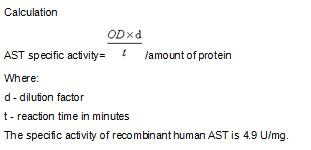
Details
ACTIVITY TEST
Buffer Formulation 20mM Tris, 150mM NaCl, pH8.0, containing 0.01% SKL, 5% Trehalose. Traits Freeze-dried powder Purity > 97% Isoelectric Point 6.6 Applications Cell culture; Activity Assays.

Aspartate transaminase(AST) or aspartate aminotransferase, also known as AspAT/ASAT/AAT or glutamic oxaloacetic transaminase, is a pyridoxal phosphate-dependent transaminase enzyme AST catalyzes the reversible transfer of an α-amino group between aspartate and glutamate and, as such, is an important enzyme in amino acid metabolism. AST is found in the liver, heart, skeletal muscle, kidneys, brain, and red blood cells. In this test, an amino group is transferred of from aspartate to ⍺-ketoglutarate. The products of this reversible transamination reaction are oxaloacetate and glutamate. The oxaloacetic acid can be decomposed into pyruvate and carbon dioxide with the present of phenylamine citrate. The activity of aspartate transaminase can be measured by calculating the concentration of the pyruvate. The reaction was performed in adding 10μl different concentation recombinant AST(the blank tube add 10μl phosphate buffer) to 50μl mixture substrate contianing 2mM 2-Ketoglutaric acid, 0.1M L-aspartic acid,<br/> in 0.2M phosphate buffer,pH7.4, incubate at 37 ℃ for 1h, then add 10μl phenylamine citrate and 50μl 2,4-dinitrophenylhydrazine continue incubate at 37 ℃ for 20min, stop the action by adding 500μl 0.4M NaOH, read the OD value at 520nm. Standard curve prepare by double dilute 2μM pyruvate with phosphate bufferr then add 10μl phenylamine citrate and 50μl 2,4-dinitrophenylhydrazine, incubate at 37 ℃ for 20min and record the OD value at 520nm. One unit of AST is the amount of enzyme that will generate 1μmole of pyruvate per minute at pH7.4 at 37 ℃.
USAGE
Reconstitute in 20mM Tris, 150mM NaCl (pH8.0) to a concentration of 0.1-1.0 mg/mL. Do not vortex.
STORAGE
Avoid repeated freeze/thaw cycles. Store at 2-8°C for one month. Aliquot and store at -80°C for 12 months.
STABILITY
The thermal stability is described by the loss rate. The loss rate was determined by accelerated thermal degradation test, that is, incubate the protein at 37°C for 48h, and no obvious degradation and precipitation were observed. The loss rate is less than 5% within the expiration date under appropriate storage condition.
Image

Figure. SDS-PAGE
Bought notes(bought amounts latest0)
User Comment(Total0User Comment Num)
- No comment


 +86 571 56623320
+86 571 56623320
 +86 18668110335
+86 18668110335

